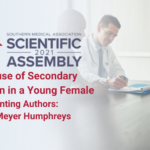Abstract | November 9, 2021
Rare Cause of Secondary Hypertension in a Young Female
Learning Objectives
- Describe an uncommon presentation of hypertension (HTN) in a young woman;
- Discuss the workup of early onset of hypertension;
- Discuss the clinical manifestations of ovarian steroid cell tumor.
Introduction: Secondary hypertension accounts for 30% of hypertension diagnoses in patients aged 18-40 years old. Typically initial differential for suspected secondary hypertension includes renal artery stenosis, thyroid dysfunction, hyperaldosteronism, cushing syndrome, and obstructive sleep apnea. Androgen and Renin- secreting tumors are a rare cause of HTN.
Case Presentation: A young female diagnosed with hypertension at18 years of age was started on a clonidine patch by her PCP. At 21years she presented with right lower abdominal pain. She was on oral birth control and had a HTN family history. Exam showed obesity, hirsutism and acanthosis nigricans. Imaging revealed a left ovarian neoplasm. Total testosterone and estrogen were markedly elevated at 638 ng/dL and 4168 pg/mL respectively. Her blood pressure (BP) was found to be 177/101mmHg. She underwent laparoscopic removal of the left adnexa; pathollogy was consistent with ovarian steroid cell tumor.
At 8 weeks postoperatively visit her BP was 136/85mmHg. Her clonidine patch was discontinued and hydrochlorothiazide was started. Her BP fluctuated between 135-170 systolic over the next 5 weeks. Approximately 4 months postop her BP was 127/76. Total testosterone and estrogen then were normal. Hydrochlorothiazide was stopped. Repeat BP checks thereafter were within normal limits.
Final/Working Diagnosis: Secondary Hypertension due to ovarian steroid cell tumor was confirmed with pathology.
Management/Follow-up: Throughout the early course of her disease, her hypertension was managed as primary hypertension.
The present case shows an abnormal, indolent presentation of a rare ovarian cancer. Ovarian steroid cell tumors often present with hirsutism, abdominal pain, distension, and menstrual irregularities, not commonly hypertension. Our patient returned to clinic in 5 weeks where blood pressure had normalized consistent with secondary hypertension. Hypertension resistant to initial treatment with antihypertensives in the presence of signs of hyperandrogenism can prompt testing of estrogen and testosterone levels for earlier diagnosis of this rare disease.

